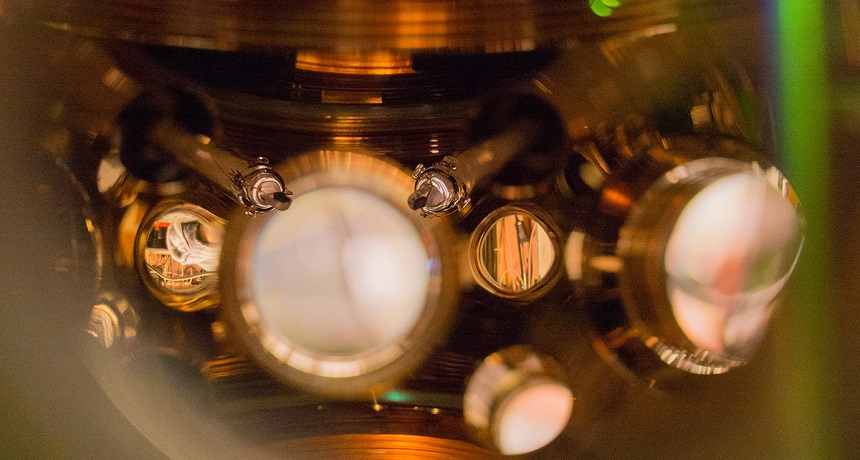News Brief: As timely as it gets
New atomic clock won’t gain or lose a second in 15 billion years

A new atomic clock contains two ultrasensitive thermometers (center) that enable scientists to reduce any timekeeping errors due to heat from the surrounding environment.
Marti/JILA
By Andrew Grant
The world’s best timepiece just got even better.
Last year, U.S. government scientists announced they had developed the world’s most accurate clock. Now, a year later, they report having modified this atomic clock. The improvements mean it should not lose or gain a second for 15 billion years. That is as much time that has elapsed since, well, the dawn of time. The changes make the clock about three times as precise as an earlier version. Details appeared April 21 in Nature Communications.
Experts in Boulder, Colo., at the National Institute of Standards and Technology and University of Colorado created the newly modified clock. It works by measuring the ticking of strontium atoms bathed in laser light. The modifications added thermometers and shielding. They reduce any timekeeping errors due to heat from the surrounding environment.
While the new clock measures the movement of atoms, particles too small to see, the equipment needed to do that takes up a room. Together, the clock’s parts weigh about a ton.
The device is so accurate that it can measure how changes in height (and the force of gravity) affect the passage of time. As Albert Einstein predicted, clocks run faster at higher elevations. In fact, scientists now say, they would notice a change in the new clock’s ticking rate by raising it just 2 centimeters (0.8 inch) above Earth’s surface.
That level of precision means a similar clock could be used to trace the shape of our planet. Increased precision also could make the global positioning system (GPS) more accurate.
Power Words
(for more about Power Words, click here)
atom The basic unit of a chemical element. Atoms are made up of a dense nucleus that contains positively charged protons and neutrally charged neutrons. The nucleus is orbited by a cloud of negatively charged electrons.
atomic Having to do with atoms, the smallest possible unit that makes up a chemical element.
atomic clock A timekeeping device that relies on the frequency of microwave emissions from excited atoms. For example, for the cesium atom that frequency is 9,192,631,770 hertz (or cycles/oscillations per second). Many common devices including cell phones, computers and GPS-satellite receivers rely on the high accuracy of atomic clocks to regularly reset their time (known as synchronization).
global positioning system Best known by its acronym GPS, this system uses a device to calculate the position of individuals or things (in terms of latitude, longitude and elevation — or altitude) from any place on the ground or in the air. The device does this by comparing how long it takes signals from different satellites to reach it.
gravity The force that attracts anything with mass, or bulk, toward any other thing with mass. The more mass that something has, the greater its gravity.
laser A device that generates an intense beam of coherent light of a single color. Lasers are used in drilling and cutting, alignment and guidance, in data storage and in surgery.
NIST (short for National Institute of Standards and Technology) Created in 1901 as the National Bureau of Standards, this government agency is now part of the U.S. Department of Commerce. It is charged with figuring out the best or most accurate way to measure things and with developing new and more accurate ways to do that measuring. To develop and test those measurement technologies, this agency has maintained one of the oldest physical science laboratories in the United States. It actually maintains several laboratories, although its headquarters is in Gaithersburg, Md.







